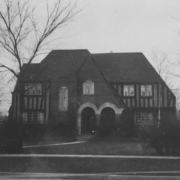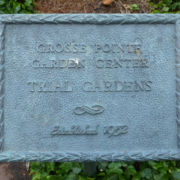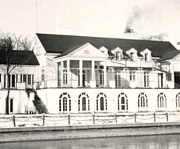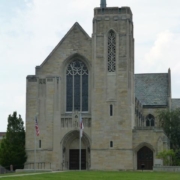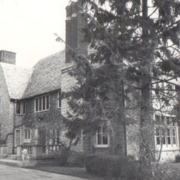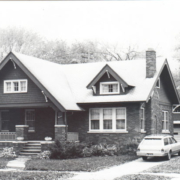Historical Architecture of Grosse Pointe – The Work Of Bloodgood Tuttle.
Having spent the past two weeks exploring two sublime homes on Woodland Place – 2 Woodland Place, and 7 Woodland Place – we now turn our attention to an architect we haven’t featured before – Bloodgood Tuttle.
Bloodgood Tuttle may not have been a prolific architect in Grosse Pointe, but he was an architect who had a stellar reputation across several states. Many such architects, who have created very few homes in our community, had worked on a large number of projects throughout the United States, and given their prominence we are rather fortunate to have some of their work on display.
Born in 1889 Tuttle was originally from Cleveland. He graduated from the University of Chicago and continued his architectural studies at the Beaux Arts in Paris. On his return to the United States Tuttle established himself in Detroit, but also practiced far and wide.
During the 1920’s he had gained a first-rate reputation for the stately residences he had created in Shaker Heights, Ohio. He was one of the best-known architects in the area, designing 36 homes. The images below are a few examples of Tuttle’s projects in Shaker Heights. Source: clevelandhistorical.org



Despite spending much of his time in Ohio Tuttle also continued to practice in Detroit and throughout the State of Michigan. His designs crossed several architectural styles, ranging from Tudor, French Châteaux through to Dutch Colonial and English manor style.
Tuttle worked primarily on residential projects, but also welcomed commercial commissions. One of his more noted projects in Michigan was the Midland County Court House, completed in 1926. Tuttle designed the building in a rustic Tudor Revival style, mainly to adhere to the style of other public buildings in the state and, indeed, the nation. The design was also, in part, influenced by a request from Herbert H. Dow, founder of the Dow Chemical Company, who had provided additional funds and materials for the build.

Midland County Courthouse – Courtesy of waymaking.com
Here in Grosse Pointe it appears Tuttle worked on at least 3 projects in the community. His first, and most impressive creation was at 223 Lakeshore, also known as the Dodge Mansion.
In 1918 John Francis Dodge hired the firm of Smith, Hinchman and Grylls to design what was intended to be the largest residence in the Detroit Area – 110 rooms, and 24 baths. According to research in Tonnancour it is understood the project was assigned to Bloodgood Tuttle to design the opulent home.

Dodge Mansion – Courtesy of Tonnancour by Arthur Woodford
During the project, in 1920, and before construction the house could be completed John Dodge – after attending an auto show with his brother in New York – died of pneumonia. His wife, Matilda, was understandably devastated and apparently could not decide whether she wanted to finish the vast stone house on Lake Shore. In 1925, after remarrying, Matilda and her new husband moved to a 320-acre property in Rochester, Michigan that John had purchased in 1907. Research from the Grosse Pointe Historical Society states the new Rochester home ‘incorporated many details (windows, stonework etc) from the unfinished home on Lake Shore’. This left the home, in Grosse Pointe, as an empty shell, with the local children having great fun playing in an around it for many years. It was finally dismantled in 1941.
In 1923 Tuttle designed two homes on Balfour – numbers 840 and 920. Balfour was a particularly prestigious street during this era, and it was a time when many grand homes were being designed for wealthy families wishing to relocate form the City to the suburbs in Grosse Pointe Park.
Number 840 Balfour is a superb 4,000 sq ft symmetrically designed French style residence. The front elevation features beautiful brick detailing around each of the 6 windows on the first floor, along with the front door.

840 Balfour – Courtesy of Realtor.com
Number 920, also built in 1923, is a striking Tudor inspired home. Similar to its close neighbor at 840, arches prove to be the dominant feature on the front elevation.
920 Balfour is currently for sale – Please call us to schedule a tour.

920 Balfour
By the 1930’s Mr. Tuttle had begun to devote much of his efforts to writing and speaking in favor of home “renovization” as a means of promoting economic recovery. He died in 1936. Source: www.case.eduhttps://case.edu/ech/articles/t/tuttle-bloodgood/
Bloodgood Tuttle was a nationally recognized architect with a first rate reputation for creating spectacular homes. He is one of several architects, with this level of reputation, who arrived in Grosse Pointe, during the 1920’s, to work on a few select projects. To view more of Bloodgood Tuttle’s residential work please click here.

We would like to take this opportunity to wish you Happy Holidays and a very happy and healthy 2018! Historical Architecture of Grosse Pointe will return on Tuesday, January 2nd with lots more historic stories.
Written by Katie Doelle
Copyright © 2017 Katie Doelle

